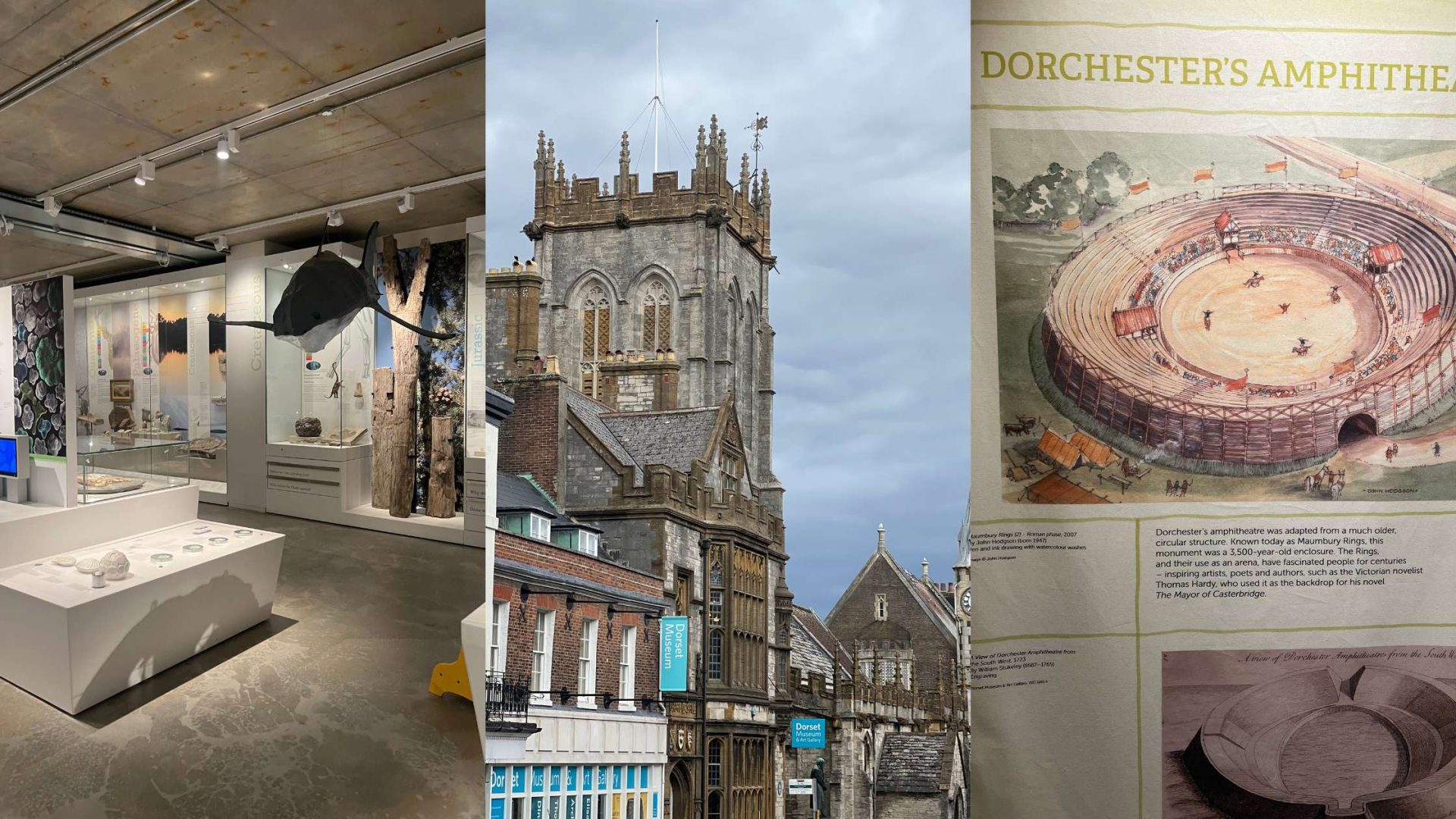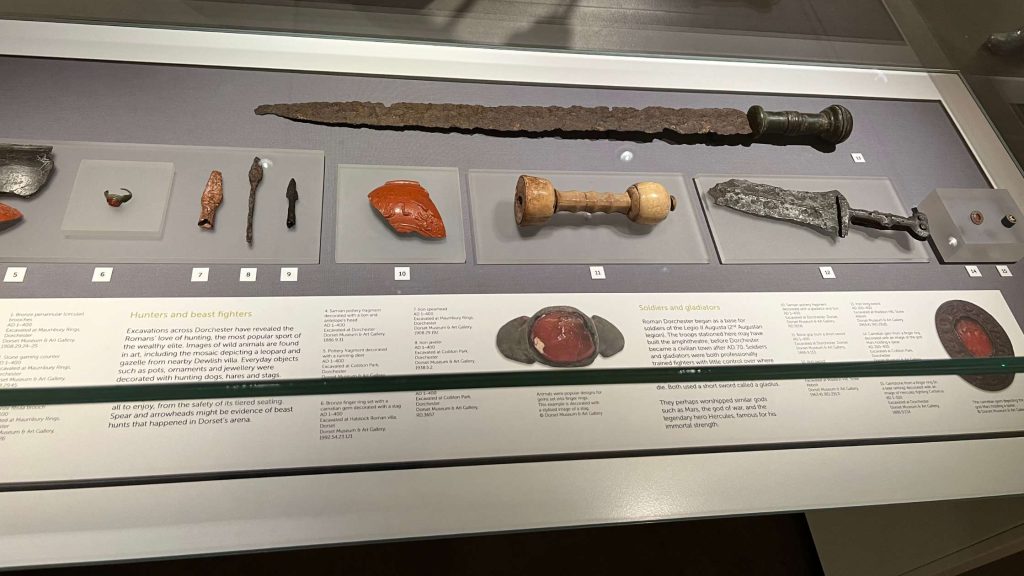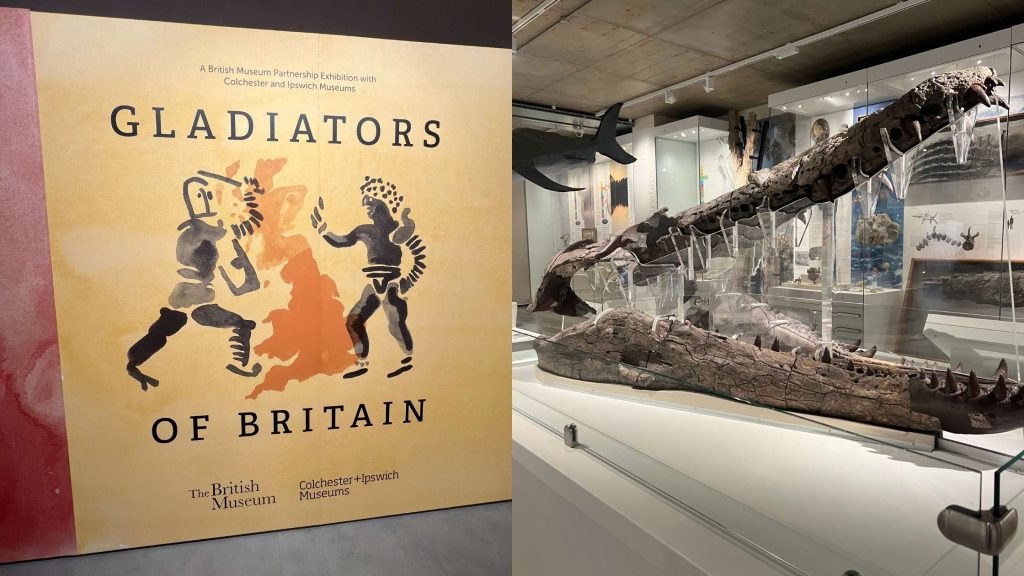

When people think of Dorset, it’s easy to picture golden beaches, chocolate-box cottages, and rolling countryside. But what many don’t realise is that Dorset is also steeped in Roman history — with Dorchester, once known as Durnovaria, serving as one of Roman Britain’s most significant settlements. On my recent trip to the Dorset Museum and Art Gallery in Dorchester, I discovered just how deep those Roman roots run at the brilliant Gladiators of Britain exhibition.
Situated in the heart of Dorchester, the Dorset Museum and Art Gallery (formerly the Dorset County Museum) is a beautifully curated space that brings the area’s rich heritage to life. Its extensive galleries cover everything from Jurassic Coast fossils to Thomas Hardy’s manuscripts — but on this visit, I was drawn straight to the Gladiators of Britain exhibition. Stepping inside felt like travelling back nearly two millennia to a time when the Roman Empire shaped daily life — even here in rural Dorset.
Dorchester itself — once Durnovaria — was a thriving Roman town, complete with grand houses, bathhouses, and an amphitheatre that could seat thousands. It’s believed that Roman citizens gathered there to watch gladiatorial contests — echoes of the spectacles once held in Rome’s mighty Colosseum. Walking through the Dorset Museum’s exhibition, it became clear that these brutal, yet fascinating displays weren’t confined to the imperial capital; they reached far into provincial towns like Dorchester, becoming part of life in Dorset.

The Gladiators of Britain exhibition at the Dorset Museum is a thoughtful and engaging exploration of Roman combat and its echoes in Britain’s western provinces. Rather than focusing solely on spectacle, it invites visitors to consider the broader role of gladiators in Roman society — how these fighters became instruments of entertainment, control, and power across the Empire, even in distant places like Durnovaria.
At the heart of the exhibition is a strong connection to Dorset’s own Roman past. Artefacts excavated locally help root the story in the surrounding landscape. Particularly striking are two Roman swords — an iron sword and a long sword — both discovered at Waddon Hill, near Stoke Abbott. These rare finds provide a tangible link to the military presence in the region, offering a glimpse into the training, violence, and authority that underpinned life in Roman Dorset.
What truly struck me was how effectively the exhibition ties into Dorset Museum’s wider celebration of local history. It’s one thing to read about gladiators in Rome, but quite another to realise that these same brutal contests unfolded right here in Dorchester. Archaeological discoveries in and around the town — some on display in the museum — show just how deeply Roman culture became embedded in local life.
Take the Maumbury Rings, for instance — a Neolithic henge that was later transformed by the Romans into an amphitheatre. These remains still sit on the edge of town and likely hosted many of Dorset’s gladiatorial games. Standing in the Dorset Museum and reading about these spectacles, I imagined the townsfolk of Durnovaria gathering at Maumbury Rings to watch men fight. It’s a chilling yet fascinating thought — that such scenes once played out in what is now a peaceful English market town.
The exhibition also delves into the politics of power in Roman Britain. Gladiatorial games weren’t merely for entertainment — they were displays of wealth and dominance by local elites seeking favour with Rome. By hosting games, rulers demonstrated their Roman credentials, reinforcing both status and loyalty. In doing so, even far-flung regions like Dorset became stages for these powerful, often brutal, displays.

After exploring the exhibition, I wandered through the museum’s other collections, which complement the gladiator theme perfectly. Mosaics, pottery, and everyday artefacts unearthed locally help paint a vivid picture of life in Roman Dorset.
It’s clear that the Roman influence wasn’t fleeting here — it helped shape the very foundations of Dorchester and its surroundings. Roads, villas, and even local place names carry echoes of that era, and the Dorset Museum in Dorchester is the perfect place to uncover those ancient layers.
For anyone staying in one of Dorset’s charming holiday cottages or visiting the area, a trip to the Dorset Museum is an unmissable experience. Whether you’re a history enthusiast, a family looking for a fun day out, or simply curious about the county’s past, this museum has something to captivate everyone.
The Gladiators of Britain exhibition adds a compelling new dimension — connecting the distant world of Roman arenas and brave (or desperate) fighters directly to Dorset’s soil. Knowing that similar spectacles once took place just a stone’s throw away, at Maumbury Rings, adds a visceral, local edge that’s hard to beat.
My visit to the Dorset Museum in Dorchester was both entertaining and eye-opening. The Gladiators of Britainexhibition is brilliantly presented, offering a fresh, localised perspective on a familiar piece of ancient history. It’s not just a tale of swords and sandals — it’s about real people, real power struggles, and how even a quiet corner of England like Dorset was part of the vast, brutal Roman world.
So, next time you’re soaking up the beauty of the Dorset countryside, spare a thought for the gladiators who fought for survival just down the road — and make time to visit the Dorset Museum and Art Gallery. You won’t regret it.